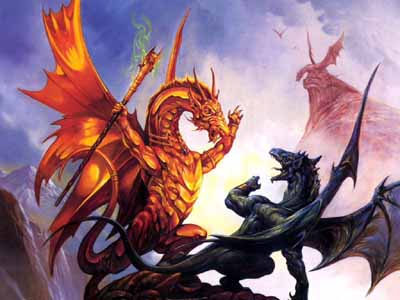Dragons

Dragons are mythical reptile-like creatures that have the ability to fly and breathe fire. Stories of these animals have spanned many cultures, religions and eras appearing in the Bible as well as in today's modern-day cartoons. The role the dragon plays varies. The dragon can be a symbol of anger and envy in some cultures while in others it is seen as a symbol of luck and good fortune. The origin of the dragon is also viewed differently by many individuals. Some believe that dragons were related to or the counterparts of dinosaurs while others believe the dragon was created in the minds of some as a reflection of their fears of snakes and other reptiles. Nevertheless, the legend of the dragon has continued to play a major part in stories such as Beowulf and in cultures around the world.
Dragons take on many faces in different cultures and religions. As we explore the legend of the dragon we see that not only do these creatures mean different things to different people, but they also look different from region to region. In Europe, dragons typically represent evil and misfortune, and they usually have wings, four legs and snake-like skin. In Western culture, dragon slaying is seen as honorable and reinforces the theme of good vs. evil as is portrayed in the stories of saints Margaret and Matthew. However, in Asia, the dragon is usually revered as a symbol of luck and fortune and combines the features of many animals such as deer horns, eagle feet, a snake's body and a lion's mane. The Asian dragon is often seen holding a pearl which signifies wisdom. The Chinese sometimes refer to themselves as "Descendents of the Dragon". In this region there are many named dragons such as the Azure Dragon which represents wood, spring and East and is a part of the Chinese, Japanese and Korean constellation.
In addition to the differences seen in the appearance of dragons by region, many believe they also come in various colors that allude to their personality. Blue dragons are calm and peaceful a characteristic often seen in many symbols for which the color is associated with. Green dragons have to do with nature and are said to have the ability to control earthquakes. Purple dragons are said to be bossy and high class. Red dragons seem to be hard to describe because of the many things the color can mean. Some say the red dragon is passionate while others say he is the angriest. Eastern dragons, however, are not described in the way above. In Asia, depending on the age and color of the dragon's parents, that dragon will be a certain color. Red dragons in Asia are born to red-gold dragons a thousand or more years old and symbolize the West. Blue dragons are the children of blue-gold dragons eight hundred or more years old and symbolize the East and the coming spring. Again we see how significant the dragon is in Asian culture.
Taking a look at Beowulf, we encounter critical differences in views of the dragon's role. One view is presented in The Dragon in Beowulf by Arthur DuBois:
First, the Beowulf dragon is not just any dragon. It is the Beowulf dragon. And the poet seems to me to spend a tremendous amount of time building up a context against which it may be seen and understood. Second, the mellowest critics concerned with the unity of Beowulf seem generally now to disagree with Klaeber in his feeling that the historical "episodes" in the last parts of Beowulf are nuisances (artistically). (822)
According to DuBois, the dragon in Beowulf signifies more than a fight between a hero and a villain. The dragon is a representation of something within Beowulf himself. This view is plausible because by the time Beowulf fights the dragon he is no longer a warrior but a king. Moreover, the dragon's rage, unlike that of Grendel, has a direct effect on Beowulf because his own hall is burnt. At this point in Beowulf's life he has to consider the safety of his people. Therefore, DuBois' view can be given fair consideration. Another view is presented by Marie Nelson in her analysis of the dragon fight in Beowulf:
Robert Kaske saw the dragon as a representation of "the greatest of internal evils, the perversion of the mind and will"…John Leyerle felt that the dragon served to reveal the concupiscence and irascibility of the hero. John Gardner agreed [with Leyerle]…but said that Beowulf's generosity and gentleness were in sharpest contrast to the behavior of the dragon. And more recently John Niles has seen the dragon's character as being morally neutral. (4)
From the above summary, it's safe to say that Leyerle and Kaske had views similar to that of DuBois in that the dragon reflects a characteristic of Beowulf. On the other hand, Gardner states that this could not be the case for the innate actions of the dragon are very different from those of Beowulf. Thus we see how the role of the dragon is often debated.
Dragons are very mysterious creatures, not because they may or may not be real, but because there is no one way to describe them. As explained, the West looks at them as evil beings while the East worships them. Even in works of literature, the dragon has many faces. Even centuries after they were first imagined, they remain a mystery.
Dragons- Works Cited
Beowulf vs. the Dragon
Beowulf Home

